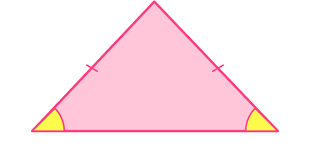
Isosceles Triangle: Ever wondered why some triangles look so perfectly balanced? That’s because they are isosceles triangles! These triangles have two equal sides and two equal angles, giving them a beautiful, symmetrical shape.
If you draw a line from the top point straight down to the base, it divides the triangle into two identical parts. This special balance makes isosceles triangles easy to recognize and fun to work with.
You can spot them in things like rooftops, road signs, and even nature. Their symmetry and structure make them important in math, art, and design. In this page, students will get the meaning of isosceles triangle, isosceles triangle definition, Types of isosceles, and properties of isosceles triangle.
Read More - Perimeter of a TriangleWhat is an Isosceles Triangle?
Learn what is isosceles triangle in this section. An isosceles triangle is a type of triangle that has two sides of the same length . The angles opposite these equal sides are also identical in measure. In other words, an isosceles triangle has two equal sides and two equal angles . For instance, in triangle △ABC, if side AB and side AC are equal, then △ABC is an isosceles triangle. This means the angles∠B and ∠C will also be equal. Accordingly, the property of an isosceles triangle can be described by the theorem as:Properties of an Isosceles Triangle
Here are the different properties of isosceles triangle:- The altitude from the vertex bisects the base into two equal segments. For example: In triangle △ABC, where AB = AC and AD is the altitude drawn from A to the base BC, the altitude divides BC into two equal segments: BD = DC.
- The altitude also bisects the vertex angle into two equal angles. For example: In triangle △XYZ, where XY = XZ and the altitude XD is drawn to the base YZ, the vertex angle ∠YXZ is divided into two equal angles: ∠YXD = ∠ZXD.
- An isosceles triangle always has two sides of the same length, known as the legs. For example, in triangle △DEF, if DE = DF, then it is an isosceles triangle.
- The angles opposite the two equal sides are always equal. For example, in triangle △PQR, if PQ = PR, then the angles opposite these sides, ∠Q and ∠R, are equal.
- An isosceles triangle is symmetric along the line that goes from the vertex to the midpoint of the base. For Example: In triangle △ABC, the line AD (the altitude) creates a mirror image of the two halves, making △ABD and △ACD identical.
- The perimeter of an isosceles triangle is the sum of all three sides.
- The area of an isosceles triangle is half the product of the base and the height (altitude).
- The angles at the base of an isosceles triangle are always equal. For example, in triangle △XYZ, if XY = XZ, then ∠Y = ∠Z.
- The vertex angle is the angle between the two equal sides. For example, in triangle △ABC, where AB = AC, the angle ∠A is the vertex angle.
Angles of an Isosceles Triangle
In an isosceles triangle, two angles are always equal, and these equal angles are opposite the equal sides. The third angle is different (unequal). If we know the measure of the unequal angle, we can use the angle sum property of triangles to find the other two equal angles.Isosceles Triangle Examples
Suppose we have an isosceles triangle where the measure of the unequal angle is 80°, and the other two angles are equal. Let the measure of the two equal angles be x. According to the angle sum property of triangles: 80°+x +x = 180° Simplify the equation: 80°+2x =180 Subtract 80° from both sides: 2x = 180°−80° = 100° Divide by 2 to find x: x= 100° / 2 =50°x Result The two equal angles of the isosceles triangle are each 50°. Therefore, the angles of this triangle are:- 80° (unequal angle)
- 50° (first equal angle)
- 50° (second equal angle)
Types of Isosceles Triangles
An isosceles triangle can be classified into three main types based on the angles between the two equal sides: acute, right, and obtuse. Let’s explore each type in detail with examples.Isosceles Acute Triangle
An isosceles acute triangle has two equal sides and all three angles measuring less than 90°. The angles opposite the equal sides are equal and acute (less than 90°).Example
In triangle △ABC :- Sides AB = AC
- ∠B = ∠C = 65°
- The unequal angle ∠A = 50°
Isosceles Right Triangle
An isosceles right triangle has two equal sides, with one of the angles being a right angle (90°). The two equal sides form the legs, while the third side is the hypotenuse.Example
In triangle △XYZ: Sides XY = XZ ∠Y = 90° (right angle) The hypotenuse is YZ By the Pythagorean theorem, if the two equal sides are of length a, the hypotenuse h is: h= √a 2 + a 2 = √2a 2 = a√2 Thus, the hypotenuse is a√2, which is approximately 1.414 times the length of each leg.Isosceles Obtuse Triangle
An isosceles obtuse triangle has two equal sides and one angle greater than 90° (an obtuse angle). The obtuse angle is between the two equal sides.Isosceles Triangle Theorems
There are two key theorems associated with isosceles triangles:- Base Angle Theorem
- Converse of the Base Angle Theorem (commonly known as the Isosceles Triangle Theorem )
Base Angle Theorem
Statement:
If two sides of a triangle are equal in length, then the angles opposite those sides are also equal.Explanation:
In an isosceles triangle, if two sides are congruent (of the same length), the angles facing these sides must also be congruent.Example:
Consider triangle △PQR where PQ = PR . According to the Base Angle Theorem: The angles opposite these sides, ∠Q and ∠R , are equal. If ∠Q measures 45° , then ∠R will also measure 45° .Converse of the Base Angle Theorem
Statement:
If two angles of a triangle are equal, then the sides opposite those angles are also equal.Explanation:
In a triangle, if two angles are congruent (equal), then the sides that are opposite these angles are also congruent.Example:
In triangle △XYZ, if ∠Y = ∠Z, then the sides opposite these angles, XY and XZ, are equal. If XY is 6 cm, then XZ must also be 6 cm.Perimeter of an Isosceles Triangle
The perimeter of an isosceles triangle is the total distance around the triangle. It is the sum of the lengths of all three sides. Since an isosceles triangle has two equal sides, the perimeter formula is 2a+bWhere:
a = length of the two equal sides b = length of the base If an isosceles triangle has two equal sides of 7 cm each and a base of 10 cm , the perimeter is: Perimeter = 2 × 7 + 10= 14 + 10 = 24 cmArea of an Isosceles Triangle
The area of an isosceles triangle is the total space enclosed within its three sides. You can calculate the area if you know the base and height, or by using the lengths of the sides if the height is not provided.Area of an Isosceles Triangle Formula:
Area =½ × base × height
Where: b = base length h = height (altitude) Example: If the base of an isosceles triangle is 8 cm and the height is 6 cm , the area is: Area = 1/2 × 8 × 6 = 24 cm 2Isosceles Triangles Practice Questions
Here are some fun and engaging practice questions to help children understand isosceles triangles:- Two equal sides of 6 cm each
- A base of 4 cm
- An isosceles triangle has three equal sides.
- The two equal sides in an isosceles triangle are called the legs.
- The base angles of an isosceles triangle are always different.
- A triangle with a 90° angle and two equal sides.
- A triangle where all three angles are less than 90°, and two sides are equal.
- A triangle with one angle greater than 90° and two equal sides.
|
Related Articles |
|
| Percentage | Surface Area of Cylinder |
| Square 1 to 30 | Square Root |
| Roman Numerals 1 to 100 | Compound Interest |
Isosceles Triangle FAQs
What is special about the height of an isosceles triangle?
Can an isosceles triangle have a 90° angle?
How do you find the perimeter of an isosceles triangle?
Is it possible for an isosceles triangle to be equilateral?
What happens to the base angles if the equal sides get longer?
How does the altitude affect the base in an isosceles triangle?










